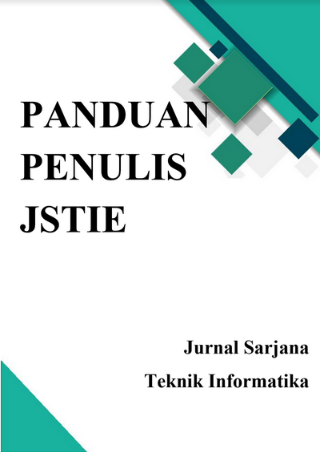SISTEM PENDUKUNG KEPUTUSAN UNTUK MENENTUKAN SUPPLIER TERBAIK MENGGUNAKAN METODE WEIGHTED PRODUCT
DOI:
https://doi.org/10.12928/jstie.v2i3.2892Abstract
Fungsi supplier sebagai pemasok barang yang sering tidak sesuai dengan yang dibutuhkan perusahaan disebabkan oleh keterlambatan waktu pengiriman, kualitas barang yang dikirim tidak sesuai permintaan dan tidak menutup kemungkinan supplier tidak dapat menyediakan barang yang diminta oleh perusahaan. Hal ini membuat perusahaan mengalami kesulitan dalam memilih supplier yang tepat sehingga perusahan harus pandai memilih supplier yang tepat. pemanfaatan Metode Weighted Product dalam menentukan supplier terbaik akan sangat membantu dalam pemberian solusi.
Â
Subjek dalam penelitian adalah aplikasi sistem pendukung keputusan untuk menentukan supplier terbaik. Metode pengumpulan data dengan metode studi pustaka, wawancara dan observasi. Tahap pengembangan aplikasi meliputi system requirements, desain model dan alur keputusan, pemodelan proses, pemodelan data, implementasi dan pengujian. Sistem yang dikembangakan menggunakan konsep Weighted Product dengan perhitungan Multi criteria decision making (MCDM) dan pengujian sistem dengan black box test dan Uji statistik hipotesa mean.
Â
Dari penelitian yang dilakukan menghasilkan sebuah perangkat lunak sistem pendukung keputusan untuk menentukan supplier terbaik dengan kemampuan yang dapat memberikan informasi dan rekomendasi penentuan supplier terbaik yang disertai dengan nilai hasil perangkingan. Hasil uji coba menunjukkan bahwa aplikasi ini layak dan dapat digunakan.
Â
Kata Kunci : Sistem Pendukung Keputusan, supplier , multi criteria decision making, Weighted product.
References
Delfmann, W., & Klaas-Wissing, T. , 2007 , Strategic Supply Chain Design: Theory, Concepts, and Applications, Kölner Wissenschaftsverlag, koln.
Winda Sulistiana., 2013, Analisis Pemilihan Supplier Bahan Baku Dengan Menggunakan Metode Fuzzy Analytical Hierarchy Process (FAHP), Skripsi S-1, Institut Teknologi Adhi Tama, Surabaya : http://jurnal.itats.ac.id/wp-content/uploads/2013/02/Analisis-Pemilihan-Supplier-B-Menggunakan-Metode-Fuzzy-Analytical-Hierarchy-Process-FAHP.pdf [3 september 2013].
Sartin., 2009, Pemilihan Supplier Bahan Baku Dengan Menggunakan Metode Multi Criteria Decision Making (Mcdm) With Promethee Dan Goal Programming Diperusahaan Azam Jaya Sidoarjo, Skripsi S-1, UPN Veteran Jawa Timur, Surabaya : http://ejournal.upnjatim.ac.id/index.php/tekmapro/article/download/309/254 [3 September 2013]
Supranto, Johannes., 2005, Teknik Pengambilan Keputusan, PT Rineka Cipta, Jakarta.
Sri Kusumadewi., 2006, Fuzzy Multi Attribute Becision Making (Fuzzy MADM), Graha Ilmu Yogyakarta.
Downloads
Published
Issue
Section
License
License and Copyright Agreement
In submitting the manuscript to the journal, the authors certify that:
- They are authorized by their co-authors to enter into these arrangements.
- The work described has not been formally published before, except in the form of an abstract or as part of a published lecture, review, thesis, or overlay journal. Please also carefully read Journal Posting Your Article Policy.
- The work is not under consideration for publication elsewhere.
- The work has been approved by all the author(s) and by the responsible authorities – tacitly or explicitly – of the institutes where the work has been carried out.
- They secure the right to reproduce any material that has already been published or copyrighted elsewhere.
- They agree to the following license and copyright agreement.
Copyright
Authors who publish with Jurnal Sarjana Teknik Informatika agree to the following terms:
- Authors retain copyright and grant the journal right of first publication with the work simultaneously licensed under a Creative Commons Attribution License (CC BY-SA 4.0) that allows others to share the work with an acknowledgement of the work's authorship and initial publication in this journal.
- Authors are able to enter into separate, additional contractual arrangements for the non-exclusive distribution of the journal's published version of the work (e.g., post it to an institutional repository or publish it in a book), with an acknowledgement of its initial publication in this journal.
- Authors are permitted and encouraged to post their work online (e.g., in institutional repositories or on their website) prior to and during the submission process, as it can lead to productive exchanges, as well as earlier and greater citation of published work.







